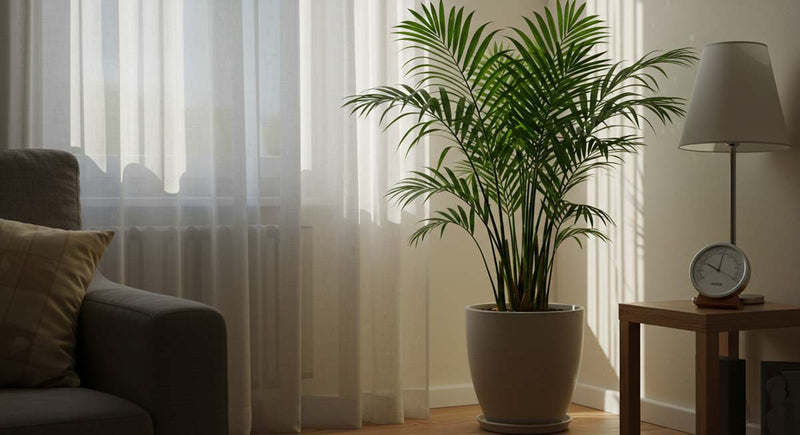Managing Humidity for Healthy Indoor Palms

Palm plants are some of the most eye-catching houseplants I’ve ever brought into my home. They give off relaxing, tropical vibes and can instantly warm up a room with their arching, leafy fronds. But it didn’t take me long to learn they can also be pretty moody if the air in the room isn't just right. One of the first clues things were off? Those dreaded brown tips. For a while, I blamed the watering routine or dry soil until I finally realized humidity had a lot more to do with it.
Indoor palms are tropical by nature, which means they’re used to warm temperatures and humid air. When we keep them inside, especially in places with dry air or during seasons when we run the heater or AC constantly, it can mess with their health. Leaves dry out, tips go brown, and if it keeps up too long, the plant starts to lose its lush look altogether. The good news is, adjusting humidity isn’t hard once I knew what to look for and how to help fix it.
Understanding Humidity And Its Importance
Humidity just means the amount of moisture in the air. Tropical plants like palms love higher humidity because that’s what they’re used to in their natural environments. When they don’t get enough, the stress shows up fast. That’s usually when I start noticing brown tips, dry edges, or leaves that feel thinner or more brittle. In some cases, leaves even curl or droop without an obvious reason.
I used to think a dry palm meant it needed more water in the soil, but overwatering can become its own issue. What was missing was moisture in the air, not just at the roots. A dry, heated room in the fall or winter made my parlor palm wilt no matter how carefully I watered it. Same goes for when the AC runs non-stop during summer. Both heating and cooling tend to suck water out of the air, leaving plants struggling to hold on to moisture through their leaves.

Palms lose water through their leaves pretty easily. If there's not enough moisture in the air to balance that out, their tips dry up because they’re not able to take in enough through the roots to keep up. Learning that helped me connect the dots and finally focus on humidity, not just soil conditions. Once I started paying attention to moisture in the air, my palms started looking fuller and greener, and those brown tips stopped popping up as often.
Optimal Humidity Levels For Palm Plants
Most palms really do best in higher humidity levels. For me, I’ve found around 50 to 60 percent humidity is usually the sweet spot for indoor palms. When levels dip below 40 percent, I start to notice signs of stress like the browning tips or yellowing leaves. Once I see that, I check my humidity levels using a small digital hygrometer. These are easy to find online, and I just keep one near my plants so I can glance at it anytime.
If the number is low, I make adjustments. But before that, I pay attention to how the leaves look and feel:
- Leaves feel crispy or dry to the touch: This usually tells me the air is way too dry.
- Brown edges starting on the tips and moving inward: Another giveaway that the air needs some moisture added.
- Slow, weak growth despite good light and water: This isn’t always humidity-related, but it often is for palms.
- Drooping when the soil feels fine: A sign the plant is off balance with its environment.
It's always wild to me how a few percentage points in humidity can make such a difference. I’ve had days where just moving a fan farther away or switching off a nearby vent helped things bounce back. If I notice consistent stress signs, I know it’s time to step in and boost the air moisture to get my palm back on track.

Ways To Increase Humidity For Your Palm Plants
Once I realized how much dry air was messing with my palms, I started trying out different ways to raise the humidity around them. Some methods worked better depending on the season or where the plant was in my house. I’ve kept it simple by rotating between a few basic tricks, and I’ve had solid results without making things complicated.
Here are the methods I use to boost humidity around my indoor palms:
1. Humidifier: This is my go-to solution when winter kicks in and the air inside gets dry from heating. I place a small humidifier near my palms and run it for a few hours in the morning. It makes a big difference fast, especially during colder months.
2. Plant grouping: I noticed that placing my palms near other houseplants actually helps build a more humid mini environment. Each plant releases a little moisture, and when they’re close together, it adds up. I cluster them gently without cramming them, giving them enough airflow but still letting them share that moisture.

3. Pebble tray: I fill a tray with pebbles and water and set the plant pot on top without letting the pot itself sit in water. As the water evaporates, the air right around the plant stays more humid. I usually refresh the water in the tray every couple of days.
4. Misting: I lightly mist my palm’s leaves every couple of mornings, especially during hot or dry weeks. I’m careful not to overdo it, since misting doesn’t replace a humidifier, but it does give the plant a little moisture boost when it needs it. I try to mist early in the day so the leaves aren’t damp overnight.
No matter which method I use, I always watch how the plant reacts and adjust based on what’s working. If a humidifier isn’t an option, even small changes like moving my palm away from the heater or simply grouping it with my philodendron or pothos can make a noticeable improvement.
Preventing And Treating Brown Tips On Palm Plants
Brown tips are such a common issue, but they’re not something I need to live with. When I start seeing them appear, the first thing I do is check humidity levels and confirm the room hasn’t dried out on me. After that, I look at watering habits. I’ve learned over time that it’s not just about adding water when the soil looks dry. Timing, amount, and even water quality all come into play.
Here’s what works best for me when I’m dealing with or trying to avoid brown tips:
- I keep my watering consistent. I wait until the top inch or two of soil feels dry, then water deeply until it drains out the bottom.
- I never let my palms sit in leftover water. That’s an easy way to trigger root rot or fungus.
- If I’m using tap water, I let it sit out overnight to let some of the chemicals break down before watering. Some palms are sensitive to chlorine or fluoride.
- I avoid placing palms right next to heat vents or cold windows. Sudden air shifts really mess with their moisture levels.
- I trim brown tips with clean, sharp scissors but I leave a small margin near the green part of the leaf. Cutting too close can send the plant into more stress.
When things are back in balance and I’ve adjusted humidity, I usually stop seeing new brown tips pop up. It takes time for old tips to heal or trim away, but the new growth tells me if I’m doing things right. As long as my plant is stretching out new green fronds and isn’t dropping leaves, I know we’re heading in the right direction.

What’s Worked for Me All Year Long
Once I got in the habit of checking humidity, caring for my palms got way easier. Instead of reacting to problems, I started noticing patterns like how heating in late fall always dried the air or how AC in July made my living room feel like a desert. I keep my hygrometer in the same area as my plants so I can glance at it without thinking twice. Just that one little tool saves me a ton of guessing.
I also rotate my plants now and then, making sure they’re not sitting in strong drafts or forgotten dry corners. Every plant is a little different, so I’ve gotten to know which ones need a little extra humidity love. I always watch my pothos and philodendron too, because they’re good early indicators. If their leaves start to get a little dull or limp-looking, chances are my palm won’t be far behind.
Caring for indoor palms doesn't mean I need an elaborate greenhouse setup. With a few smart habits, a little observation, and a pinch of patience, I’ve been able to keep my palms looking healthy and green through every season. The key is treating humidity like any other part of plant care, just like watering or getting the light right. Once I found that balance, everything else started growing a lot more smoothly.
Caring for indoor palms can seem tricky with issues like brown tips on palm plants, but it doesn’t have to be overwhelming. If you’re finding those brown tips are a recurring problem, it might be time to consider adding a nutrient-rich solution to your routine. At Houseplant Resource Center, we’ve got a soil blend made just for indoor plants that helps maintain the moisture balance your palms need. Whether you’re dealing with humidity control or just want to promote healthier growth, our curated tips and products are here to help you keep those beautiful green fronds thriving year-round.




